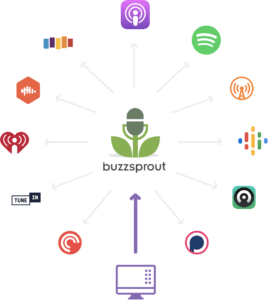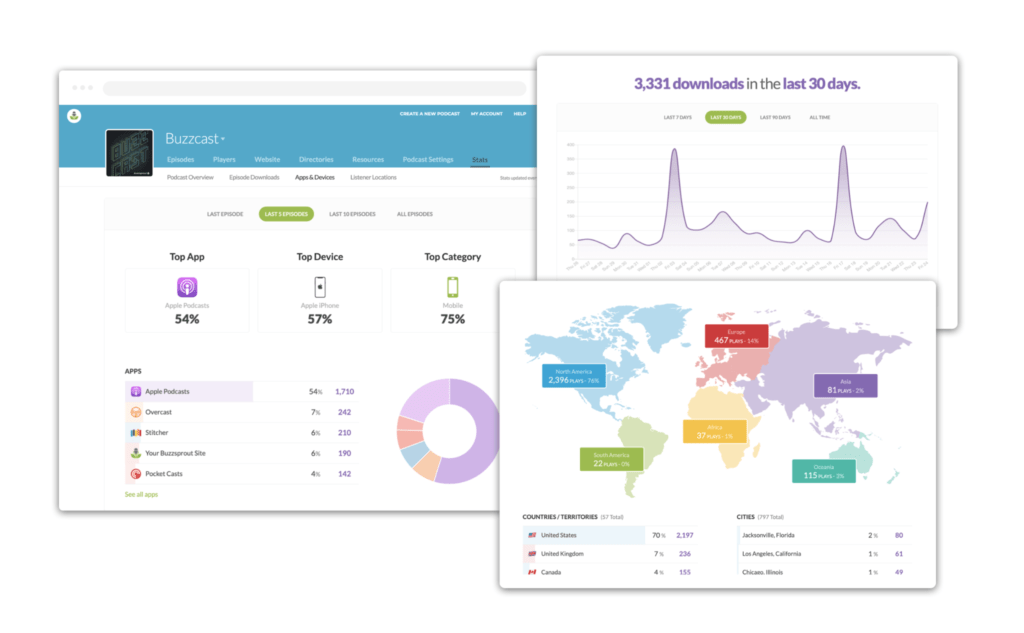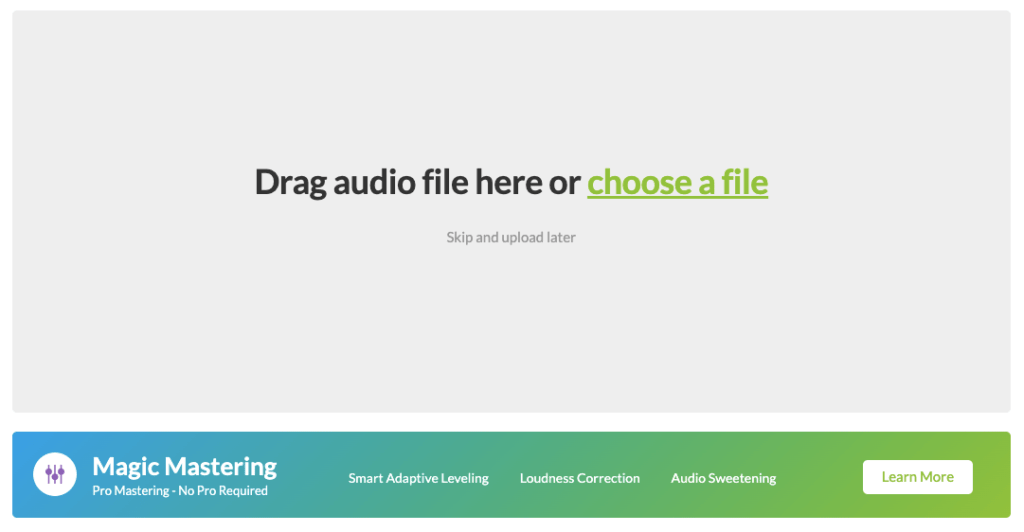
The Ultimate Buzzsprout Review: Is It Worth the Hype in 2023?
In the world of podcasting, choosing the right hosting platform can make all the difference in the success of your show. One platform that has been making waves in recent years is Buzzsprout. With its user-friendly interface, customisable player, and a variety of features, it’s no wonder that so many podcasters have turned to Buzzsprout to host their shows. In fact, to date, over 100,000 active podcasts are hosted on Buzzsprout.
But with so many other options available, is Buzzsprout really worth all the hype?
In this review, we’ll take a closer look at Buzzsprout and its features to help you decide if it’s the right choice for your podcast in 2023.
So whether you’re a seasoned podcaster or just starting out, read on to find out if Buzzsprout is the ultimate hosting platform for your show.
What is Buzzsprout?
Buzzsprout is a podcast hosting platform that allows you to easily upload and distribute your podcast to all major podcast directories, including Apple Podcasts, Spotify, and Google Podcasts.
The platform was founded in 2009 and has since grown to become one of the most popular hosting options for podcasters. Since starting, Buzzsprout has helped over 300,000 podcasters to launch their shows.
Buzzsprout offers a variety of features to help you create, upload, and promote your podcast, including a customisable website, detailed analytics, and monetisation options.
Why is a podcast hosting platform important?
When you create a podcast, you need a place to host your audio files so that they can be distributed to all major podcast directories.
This is where podcast hosting platforms come in.
A podcast hosting platform stores your audio files and generates an RSS feed that can be submitted to directories like Apple Podcasts and Spotify. You can read more about what an RSS feed is in this post: What is a Podcast?
Without a hosting platform, your podcast would not be accessible to listeners.
Additionally, a good podcast hosting platform can provide you with tools to help you create and promote your podcast.
And this is why I love Buzzsprout. Because it has all of the features and tools you could need and then some.
What is the difference between a podcast hosting platform and a podcast directory?
A podcast hosting platform, like Buzzsprout, stores your audio files and generates an RSS feed that can be submitted to podcast directories.
A podcast directory, on the other hand, is a platform that aggregates podcasts from various sources and makes them available to listeners.
Examples of podcast directories include:
- Apple Podcasts
- Spotify
- Google Podcasts
- Amazon Music
- iHeartRadio
- Stitcher
- Pandora
While it is possible to self-host your podcast and submit your RSS feed directly to directories, a hosting platform like Buzzsprout can make the process much easier and provide additional features and analytics.
What else do I need to start a podcast?
In addition to a podcast hosting platform, you will need a few other things to start a podcast. First, you will need a microphone to record your audio.
There are many different microphones available, ranging from inexpensive USB microphones to professional-grade XLR microphones.
I currently use the very-affordable Blue Yeti microphone, and it’s what I recommend to everyone when they ask me for microphone recommendations.
You will also need audio editing software to edit your recordings and create your final episodes. My preferences are Zencastr, Descript, or Garageband
Finally, you will need a topic for your podcast and a plan for how you will create and promote your episodes.
Just starting your podcast? Check out this post – From Idea to Launch: How to Start Your Own Podcast >>
Top Buzzsprout features
Custom website
One of the standout features of Buzzsprout is the ability to create a custom website for your podcast.
This website can be customised with your branding and includes a player that allows listeners to listen to your episodes directly on your website.
The website also includes links to your podcast on all major directories, making it easy for listeners to subscribe and listen to your show.
Embeddable players
Once you have an episode published, you can create embeddable players to put on your own website.
You have the option of embedding either a solo episode or multiple episodes in one player.
Solo episode embeds are good if you’re creating a blog post or episode page on your own website as then you can embed the player for listeners to listen to the episode as well. This is something that we’ve done with The Lazy Girl’s Guide to Podcasting episodes. Here’s an example: How To Have A Successful Podcast – Hint; It’s Not What You Think!
Multiple episode players can be used on other parts of your website like we’ve done here on our homepage.

Easy-to-use layout
Buzzsprout has a user-friendly interface that makes it easy to upload and manage your podcast episodes.
The platform has a simple drag-and-drop interface that allows you to upload audio files, add episode descriptions, and create show notes.
Additionally, Buzzsprout provides you with detailed instructions and support to help you get started.
Monetisation opportunities
Buzzsprout offers several monetization options for podcasters, including dynamic ad insertion and a listener support feature.
Dynamic ad insertion allows you to automatically insert ads into your episodes, while the listener support feature allows listeners to support your show with monthly donations.
Both of these features can help you generate revenue from your podcast.
Visual soundbites
Buzzsprout’s visual soundbites feature allows you to create shareable clips from your episodes that include an animated waveform. These clips can be shared on social media to promote your show and drive traffic to your website and podcast.
Transcripts
Buzzsprout allows you to upload transcripts to your podcast episodes, something that can be helpful for SEO and accessibility purposes.
They are also beneficial for listeners who prefer to read or follow along with the audio. Transcripts can be used to create blog posts, show notes, and other written content based on your podcast episodes, expanding your reach to audiences who may not consume podcasts in their traditional audio format.
You can either copy and paste your transcript across or use one of Buzzsprouts integrations to add your transcript in.
Currently, Buzzsprout can be integrated with:
- Otter.ai
- Descript
Where does Buzzsprout publish to?
Buzzsprout publishes your podcast to all major podcast directories, including Apple Podcasts, Spotify, Google Podcasts, and more.
Additionally, Buzzsprout provides a customisable website for your podcast that includes links to all of the major directories that your podcast is listed on.

Once you’ve created your first podcast episode in Buzzsprout, you can submit your podcast to directories directly from the Buzzsprout dashboard.
To do this, navigate to the ‘Directories’ section of your Buzzsprout account and select the directories you want to submit your podcast to. Buzzsprout will then guide you through the submission process, providing you with specific instructions for each directory.
The submission process may vary depending on the directory you are submitting to, but typically involves giving the directory your RSS feed. Although, some you just hit ‘Submit’ and Buzzsprout does everything for you!
Some directories might also need you to fill out information about your podcast such as its title, description, category, and cover art.
Once you’ve completed the submission process, it may take several days for your podcast to be approved and listed in the directory. But, in my experience, approval and listing can take anywhere from 1 hour to 3 days.
The good thing about the submission process is that it is a one-time process for each directory. Once you have been approved by the directory, Buzzsprout sends any new episodes or podcast updates to the directories that your podcast is listed.
Do I need to be listed in every directory?
My personal recommendation is not to limit the podcast directories that you are listed on. The more you are on, the more likely new listeners are to find you. Although at an absolute minimum, you need to be on the two biggest podcast directories; Apple Podcasts and Spotify.
Buzzsprout analytics and metrics
Buzzsprout provides detailed analytics and metrics to help you track the performance of your podcast. This includes information on your episode downloads, listener demographics, and more.
Analytics that you can track directly in Buzzsprout include:
- Overall downloads in the last 7, 30, and 90-day periods, as well as all time and customised date ranges.
- Episodic downloads in the last 7, 30, and 90-day periods, as well as all time and customised date ranges.
- The apps and devices that your listeners use to listen to your podcast.
- Locations of your listeners, broken down by continent, country, and city.
There is also an ‘Achievement’ section which releases social media graphics for you to use when you hit certain episodes and download milestones.
For more in-depth analytics and metrics, you can go into individual podcast directories. Additionally, you can use a platform such as Chartable or Podkite to see where your podcast is charting both nationally and internationally.

Magic Mastering
Buzzsprout’s Magic Mastering feature is an advanced audio processing tool that optimises the sound quality of your podcast episodes automatically. Buzzsprout markets Magic Mastering as ‘an Instagram filter for your audio.’
Magic Mastering uses advanced technology to analyse and enhance the audio quality of your recordings, making them sound more professional and polished.
One of the benefits of Magic Mastering is that it saves you time and effort that you would otherwise spend on manual post-production editing. It also ensures that your podcast episodes sound consistent across all episodes, which can enhance your listener’s experience.
Magic Mastering is not included in Buzzsprout’s monthly plans, though, and does require an additional charge which is between $6USD and $12USD per month depending on the plan that you’re on.
Buzzsprout customer support
Buzzsprout offers excellent customer support to help you with any issues or questions you may have.
I’ve had to use them a couple of times and each time they have responded and resolved my issue within 24 hours. And the issue wasn’t even an issue, it was just support when I was integrating Buzzsprout with another platform.
Buzzsprout also has a detailed knowledge base with articles and tutorials, as well as their own online course to get you going.
Chapter markers
Buzzsprout allows you to add chapter markers to your episodes. These are very much like the chapter markers that you can find on YouTube videos.
By using the chapter marker feature, you can enable listeners to easily skip to specific sections of your episode, making it easier to find the content that they are interested in.
How to set up your Buzzsprout account
Setting up a Buzzsprout account is really quick and easy. Simply go to the Buzzsprout website and click ‘Get Started Free’.

Enter your details and follow the instructions to verify your account.

Once you have created your account, you can start uploading your podcast episodes and customising your podcast’s website.
If you want more in-depth tutorials to set up your Buzzsprout account, we’ve got you covered. The Confident Podcaster is our signature online course that teaches you how to create a successful podcast.
It is jam-packed with tutorials that guide you through setting up some of the most popular podcasting tools available, including Buzzsprout, Zencastr, Descript, and so much more!
Find out more about The Confident Podcaster >>
How to upload your new podcast episode to Buzzsprout
To upload a new podcast episode to Buzzsprout, simply log in to your account and click on the ‘Upload a New Episode’ button.

From there, you can upload your audio file by either dragging and dropping it, or choosing a file from your computer to upload.

Then, simply add episode details and show notes, publish your episode, save it as a draft, or schedule it for publishing on a future date.
Buzzsprout pricing plans
Buzzsprout offers several pricing plans to fit your needs and budget. The plans range from a free plan with limited features to a premium plan with unlimited storage and advanced analytics.

Does Buzzsprout upload to Apple Podcasts?
Yes, Buzzsprout uploads your podcast to Apple Podcasts, as well as all other major podcast directories.
Does Buzzsprout upload to Spotify?
Yes, Buzzsprout uploads your podcast to Spotify, as well as all other major podcast directories.
Is Buzzsprout good for beginners?
Yes, Buzzsprout is a great option for beginners.
The platform has a user-friendly interface and provides detailed instructions and support to help you get started.
Does Buzzsprout have an app?
No, at the time of writing Buzzsprout does not have an app.
However, the platform is mobile-responsive and can be accessed from any device with an internet connection.
Does Buzzsprout have a free plan?
Yes, Buzzsprout offers a free plan with limited features. However, the free plan includes all major podcast directories and allows you to upload up to two hours of content per month.
On the free plan, you can:
- Upload 2 hours of audio each month
- Host your episodes for 90 days
- Have access to advanced statistics
- Have unlimited team members
The biggest drawback of the free plan is that after 90 days your podcast episodes will no longer be hosted.
However, if you want to test Buzzsprout out, you can essentially use the 90 days as a 3-month free trial. When you look at it like that, it’s a pretty good deal. Just remember to upgrade to a paid-for plan before your first uploaded episode reaches its 90-day limit to avoid any content disappearing. Don’t worry – Buzzsprout alerts you when your 90-day limit is approaching!
What alternatives are there to Buzzsprout?
There are many podcast hosting platforms available, including:
- Libsyn
- Simplecast
- Transistor.fm
- Anchor.fm
- Captivate
- Podbean
- Acast.
Each platform has its own set of features and pricing plans, so it’s important to do your research and choose the platform that best fits your podcasting needs and budget.
Conclusion – Is Buzzsprout worth the hype in 2023?
After reviewing the features and benefits of Buzzsprout, it’s clear that the platform lives up to the hype.
I’ll admit that I am biased because I host both of my podcasts on Buzzsprout. However as I’d had such a good experience hosting The Confident CEO on Buzzsprout, it seemed the obvious choice to also host The Lazy Girl’s Guide to Podcasting there as well.
Buzzsprout offers a variety of features to help you create, upload, and promote your podcast, including a customisable website, detailed analytics, and monetisation options.
Additionally, Buzzsprout provides excellent customer support and is a great option for beginners.
While there are other podcast hosting platforms available, Buzzsprout is a top choice for podcasters looking for a reliable and user-friendly platform.
If you’re looking for a podcast hosting platform that can help you take your show to the next level, Buzzsprout is definitely worth considering.
Get 3 months of podcast hosting for free with Buzzsprout >>






2 Comments
Fransic verso
First time to know about this platform and I will keep it in mind. Because I will start a podcast soon. Thank you for the review!
Verity Sangan
Good luck in your podcasting journey! I’m glad you found the review useful!